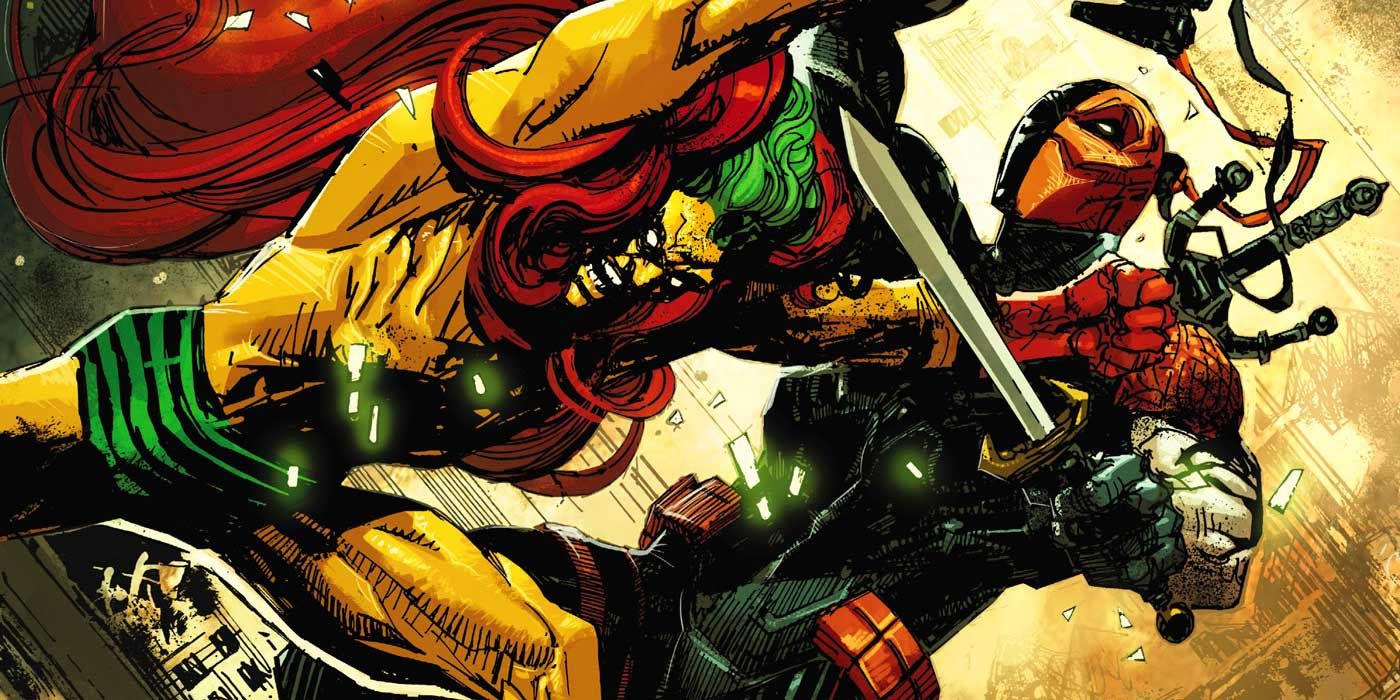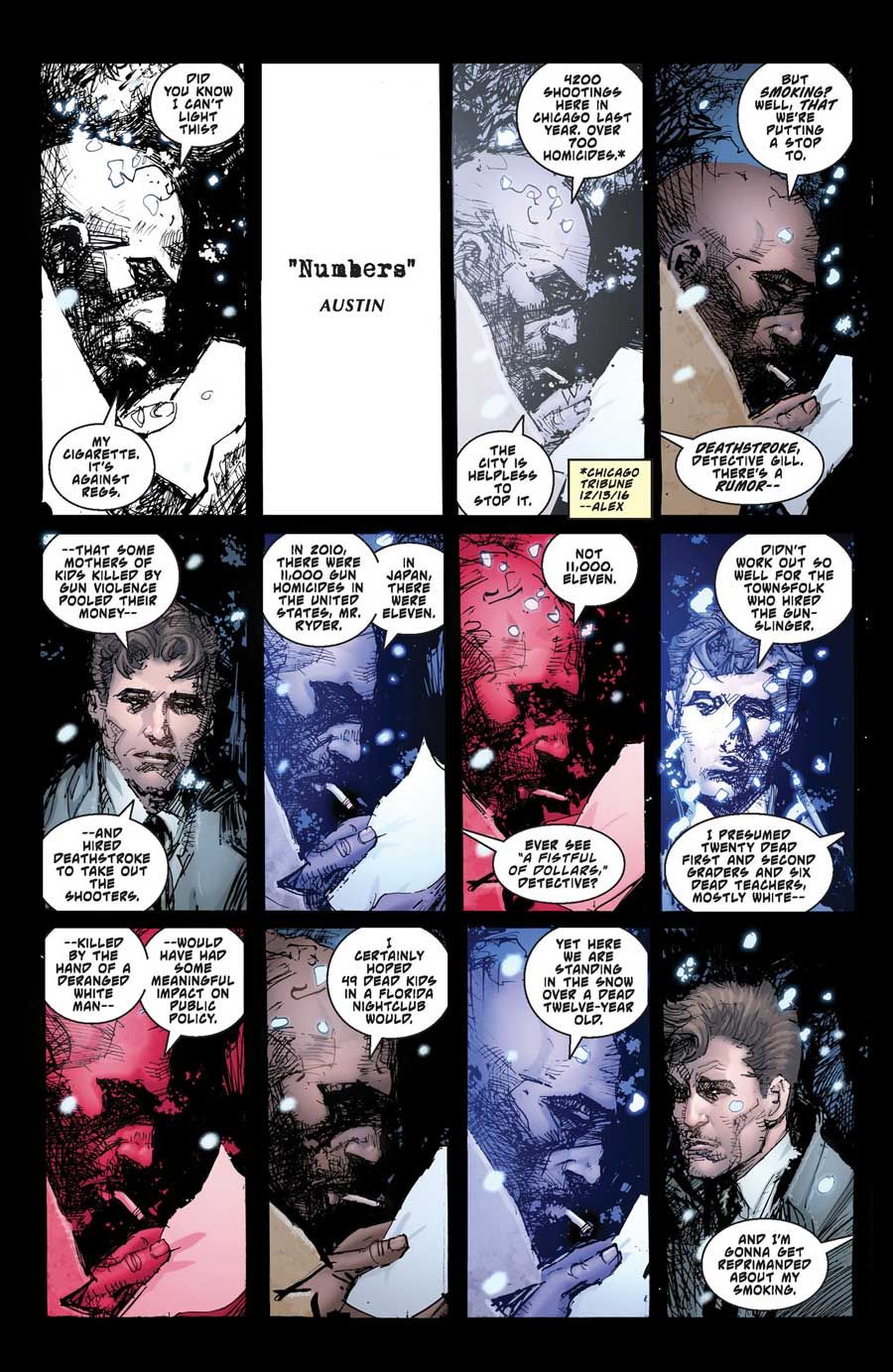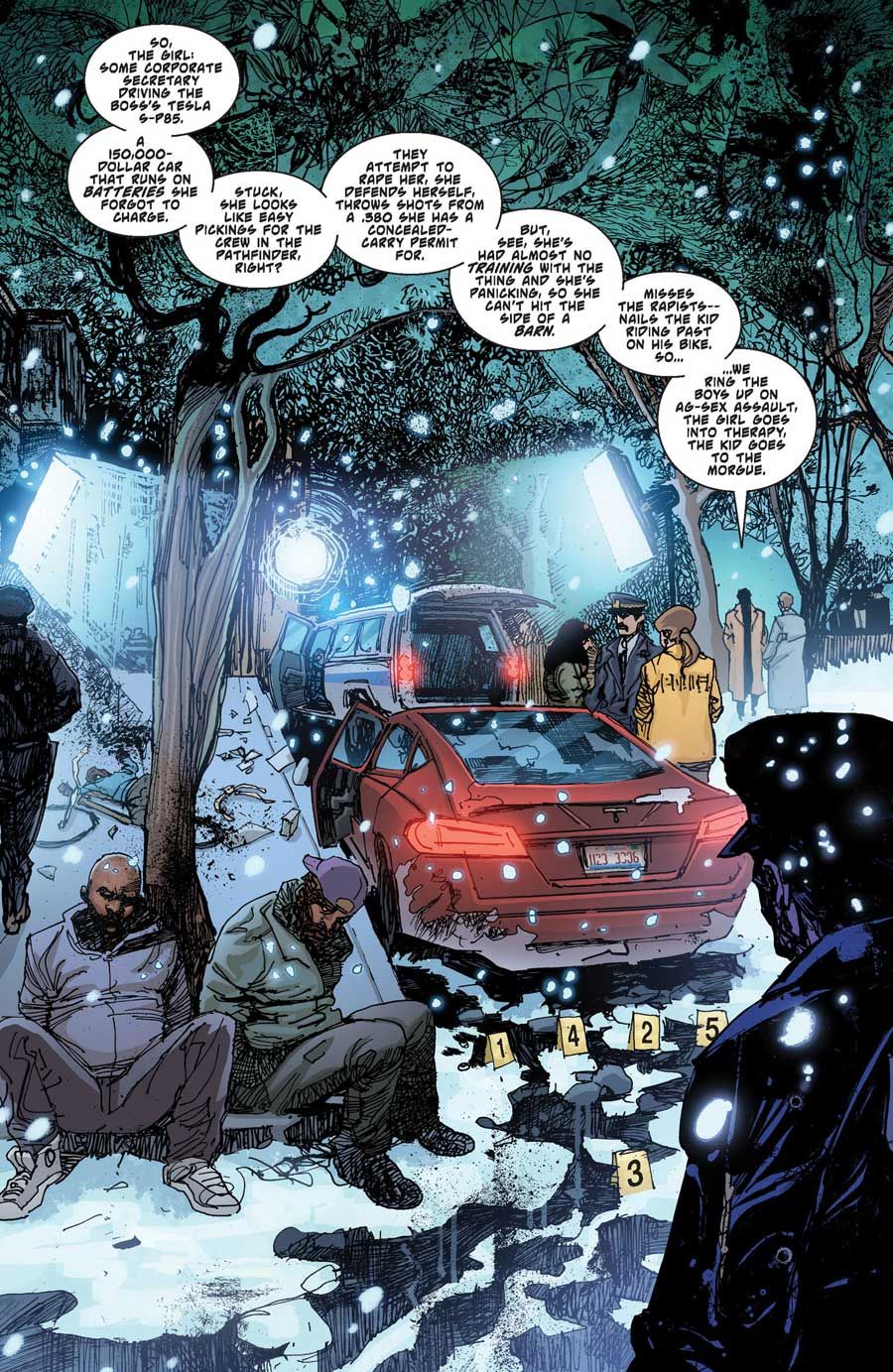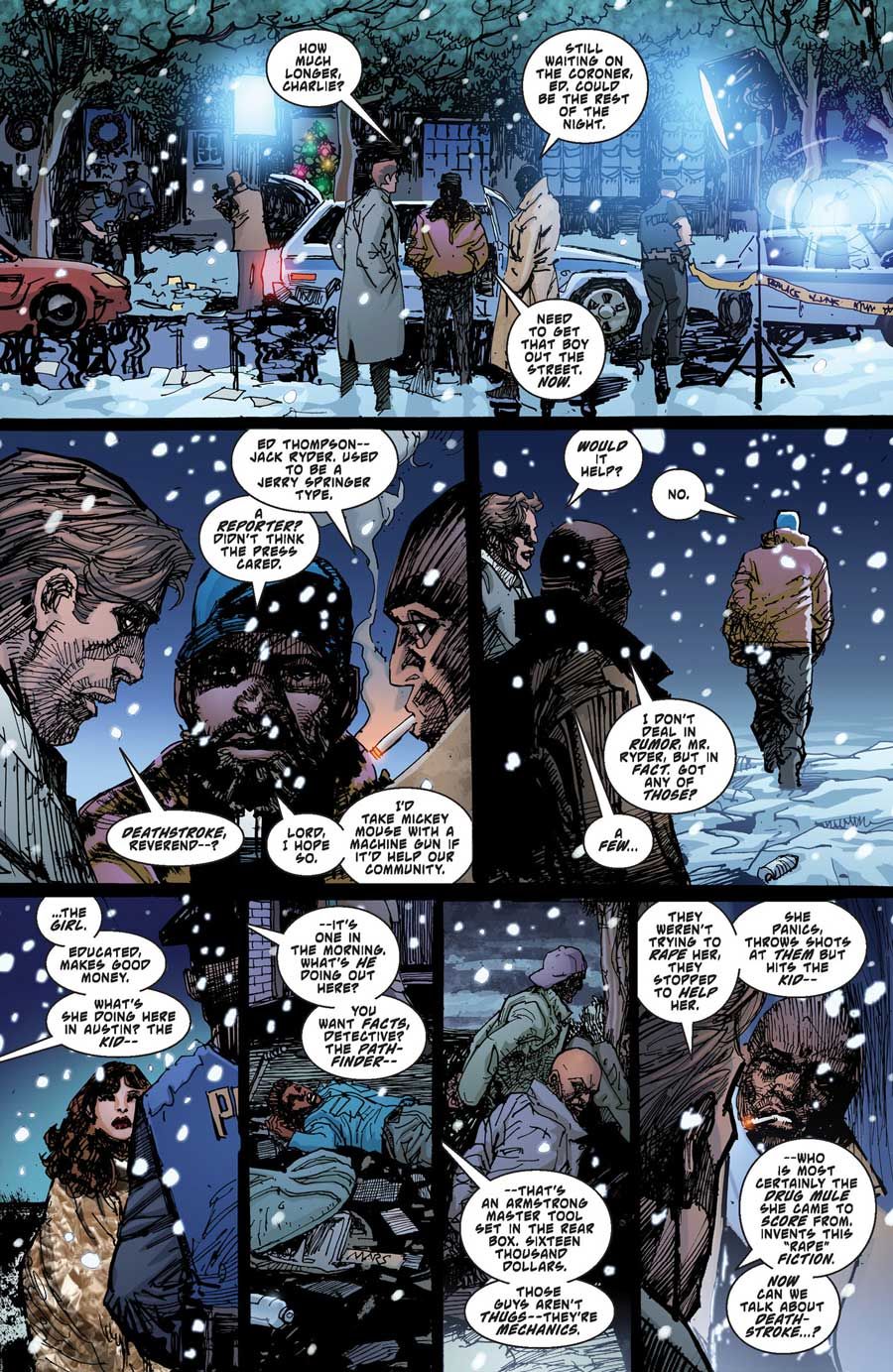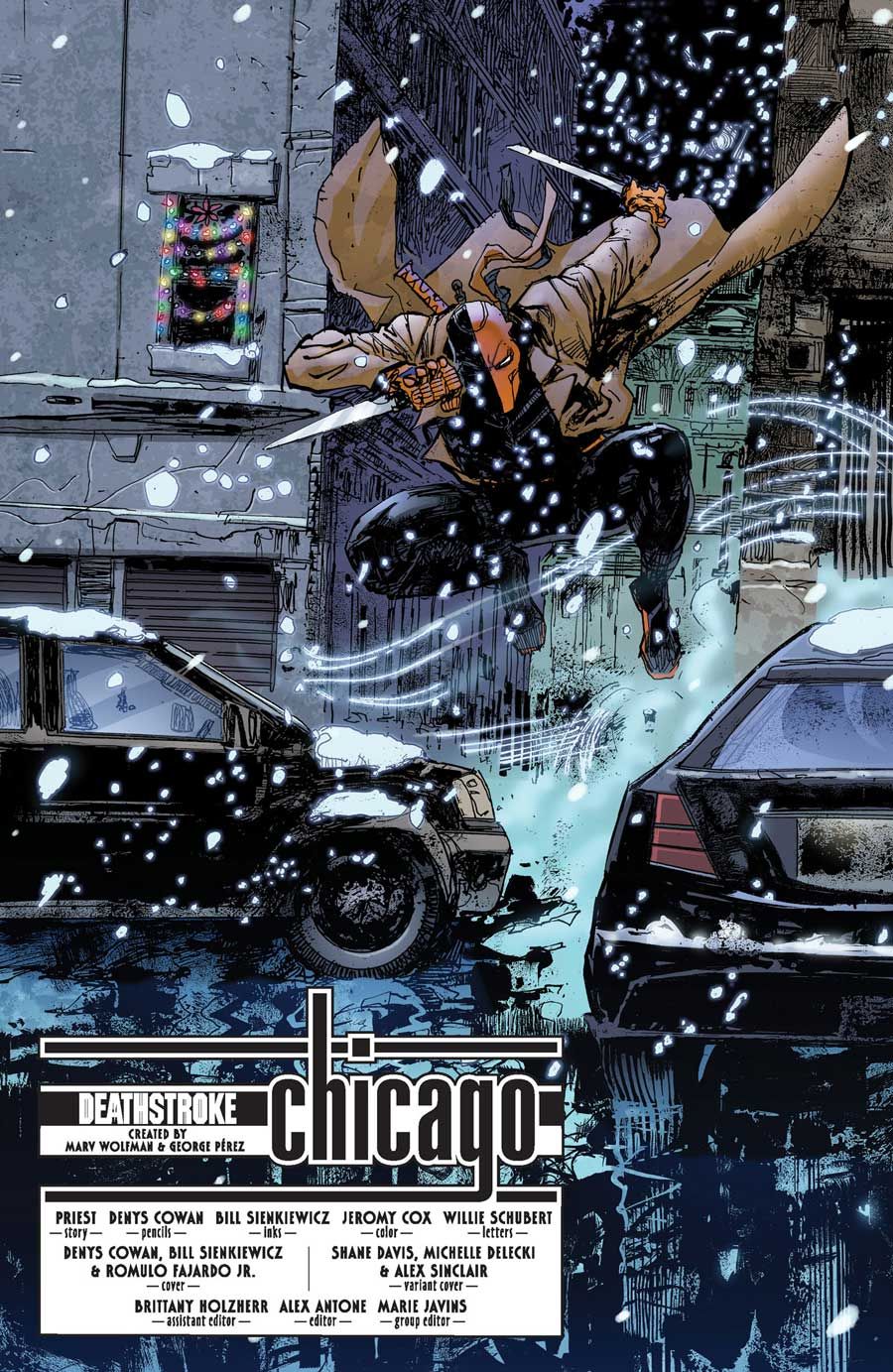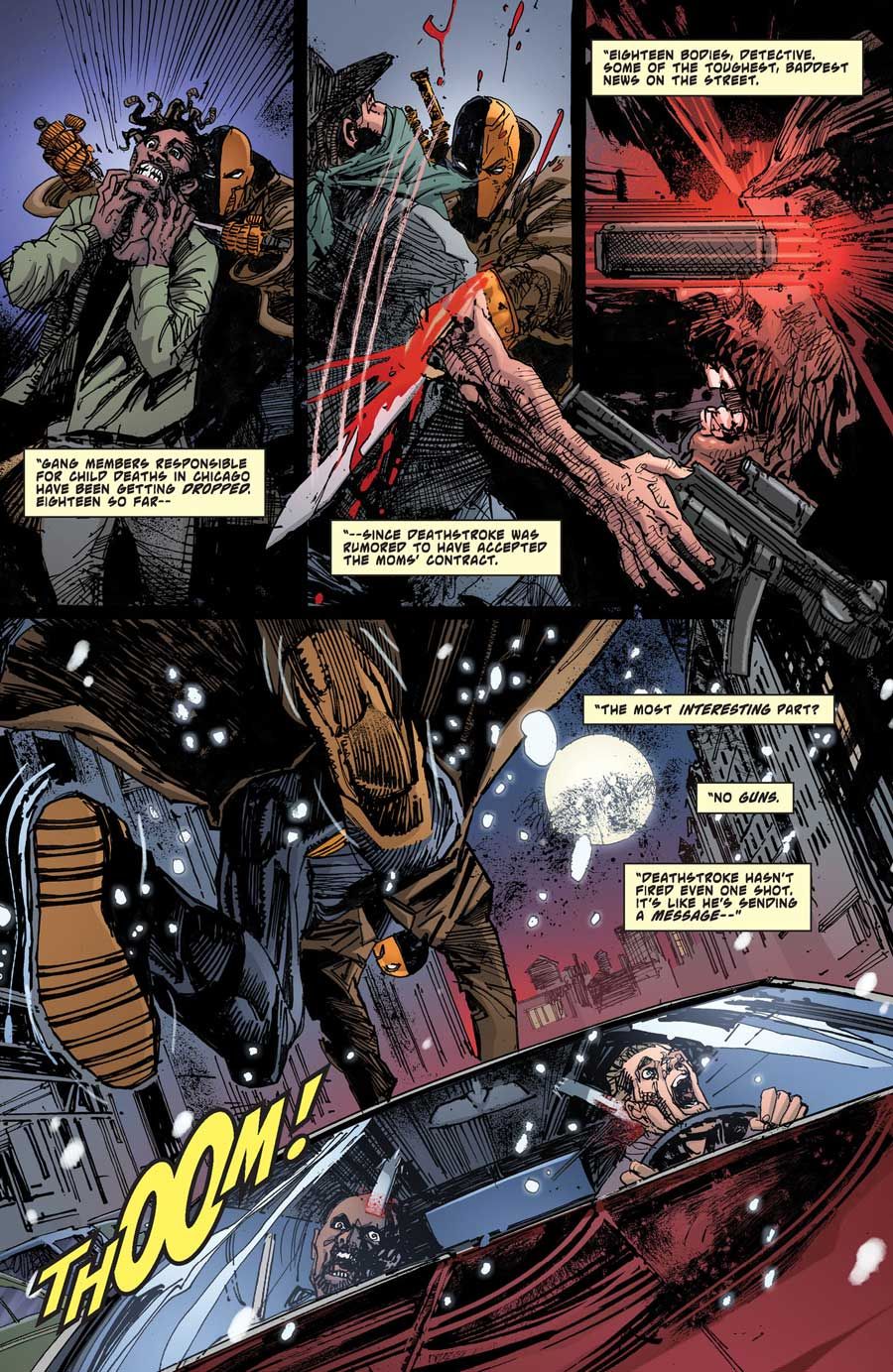SPOILER WARNING: The following interview contains spoilers for "Deathstroke" #11, in stores now.
All these months later, and storied DC Comics characters are still lining up for their respective debuts in the publisher's Rebirth reality. This week sees the reemergence of that jaundiced, feral freak, The Creeper, along with his Fourth Estate alter ego, Jack Ryder. To make the return all the more odd, it takes place in the pages of "Deathstroke #11," by Christopher Priest and guest artists Denys Cowan and Bill Sienkiewicz.
Priest and company have hardly taken the typical approach to Slade Wilson or his terminations with this series, opting instead for something just as violent, but far more introspective. That's especially evident with this latest issue, a frank examination of gun violence and vendetta--not in Gotham or Metropolis, but real world Chicago. When multiple perpetrators of gang murder turn up dead themselves, journalists flock to cover the story of a potential serial killer. Is this justice, or the kind of "eye-for-an-eye" vigilantism that only feeds the cycle of violence? Perhaps an assassin with an eye-patch may prove the best testimony.
CBR: Chicken and egg question: Did Deathstroke #11 start with the outline, or the knowledge that Denys and Bill would be the art team?
Christopher Priest: The issue began as an inventory story, which is an issue we prepare and hold in case there are production or scheduling problems with the book. I wanted to do an anti-violence story and thought, what better place to do an anti-violence story than Deathstroke -- a book that all but glorifies violence. As I see it, my run does not glorify violence so much as it examines the consequences of violence and the effect living this lifestyle has on this man Slade Wilson. I thought a stand-alone inventory issue would be a great platform to make a more forward-leaning statement about those consequences.
At the time of commissioning, there were many stories about the rising toll of shootings in Chicago, with 2016 being a record-breaking year in terms of gun violence and homicides. I thought this tragic situation would make an appropriate platform for my story, and discussed it initially with film director and producer Reginald Hudlin ("D’Jango Unchained," "2016 Academy Awards®," "Marshal"), who is now a principal in Milestone Media Inc. I invited Reginald to co-write the issue, but he was busy at the time directing the upcoming biopic "Marshal." He did share his views on the culture of violence—including Hollywood’s role in it—and suggested my story might work as an urban spin on the classic western "A Fistful of Dollars," wherein the beleaguered townsfolk hire the gunslinger Clint Eastwood to resolve their problems by means of violence. "Dollars" is a cautionary tale and an anti-violence statement in its own right, and Reginald’s suggestion provided the direction I ultimately pursued.
I thought the story would be a great fit for Milestone Media in its renewed relationship with DC Comics, and had hoped for a mini Milestone reunion by inviting Reginald and Milestone co-creator Denys Cowan to join me. I was incredibly pleased when Denys said yes and worked the "Deathstroke" story into his busy schedule. Denys then brought along our longtime friend Bill Sienkiewicz as well as longtime Cowan letterer Willie Schubert ("The Question," "Legends of The Dark Knight," "Lone Wolf & Cub").
Was there ever any resistance to this story?
Priest: DC has been unqualified in their support of this story. I was actually prepared for a fight and kind of expected the story to get dumped somewhere along the approvals process, but both Bob Harras and DC Publisher Dan DiDio were extremely supportive, making me feel a little like a dope for, essentially, doing to the company what I’d experienced for so long -- making assumptions along cultural lines. I kind of owe the company an apology for my having suited up for a fight that never happened.
Obviously, every project is different, with its own mood and pace. Denys, were there any particular challenges when putting pencil to paper on this one? Anything you wanted to try?
Denys Cowan: The challenge of this story was to try to convey the city of Chicago and the people who live there, because the city is as much of a character in this story as Deathstroke is. I tried my best to show this... and with the excellent story by Priest and the inks by Sienkiewicz, I’m very happy with the way this issue came out.
I don’t imagine this applies to anyone on this call, myself included, but there are those who don’t want politics to infringe on the escapism of their comics reading experience. What’s your take on that?
Priest: Read other comics. [Laughs] The way I see it, there are so many choices these days and so many genres from both major and indy publishers, that there should be room for a myriad of approaches. You know, once there was a Cary Bates approach and a Denny O’Neil approach, with Chris Claremont emerging as a kind of amalgam of the two: the high-energy larger-than-life superhero action but character-driven and grounded in reality.
DC films are very much grounded in reality, while the main grouping of their superhero comic books tend to read more like animated series in terms of their heightened reality and high-octane action. Everything is really loud and really bright and occasionally silly, with colorful villains like Abra Kadabra and so forth. But The Dark Knight was so good, it actually worked without the costumes. I mean, if Bruce Wayne had been a Bond-style vigilante rather than Batman, that movie would have still worked.
If I were writing Justice League, the book would probably not be something DC fans would want to read because it would be far less larger than life and would echo life as we know it. I mean, what if there really were a self-appointed group of godlike people “protecting” us? How would the world respond to these people? My JL book would examine the real-world conflicts, challenges and consequences and be less concerned about the next galactic menace the heroes would have to fight.
This isn’t to criticize writers who write the bang-zoom stuff; these are very talented people doing a great job. But I, personally, don’t read those comics unless I have to for research because they don’t appeal to me, and nobody is writing "JLA: The Real World," which would appeal to me. It’s also possible I am simply not the audience for mainstream superhero comics because so much of it is just too cranked and too loud for me. I want the real world—or as close to it as I can get—and then pop the heroes into it.
Cowan: This isn't a political issue to me. Gun violence is a human problem. We deal with this subject in the context of a thriller type story.
Still others might ask why Deathstroke the Terminator is the right guy to relay questions about the cycle of violence in the real world. Do you think audience perception of Slade is a hurdle or an advantage in telling a really charged, meaningful story?
Priest: I think only Nixon could go to China. If DC is going to do an anti-violence story, it really has to take place in "Deathstroke" in order to have real credibility. You had to send the most staunch anti-Communist crusader to talk to Mao in order for any agreement to be trusted by both sides.
I went into this one cold. In fact, I read this digitally without having seen the cover. So when the Creeper shows up, it was maybe the last cameo I expected to see. It’s almost a shame most other readers will have already seen him on the cover. How did the Creeper become part of the equation?
Priest: For this story, I wanted Deathstroke to be portrayed, more or less, as a force of nature. He has very few lines. The story is told by a point of view character. I thought that POV character should ideally be a reporter; someone who could ask questions. I did not want to the book to preach to the readers “Violence Is Bad!” I wanted to preach a good sermon. A good sermon is like a good court summation: tell a story, ask pointed questions, which lead the hearer to draw their own conclusion.
I initially wanted Lois Lane, but there was so much going on in the Superverse that we looked elsewhere. When Jack Ryder came across my desk, I felt Ryder — a former Jerry Springer-type — would be perfect. The story is built around Ryder however, as it developed, it became obvious that if we have Ryder in the book, readers would expect The Creeper to make an appearance.
I actually did not want Creeper on the cover, but this is the first post-Rebirth appearance of the character, so it made sense that DC would want to play that up. Hopefully, the way the book is written, most readers will have all but forgotten about The Creeper until he makes his entrance. I think it still works.
What’s important to you right now, as storytellers in, let’s call it 2017? What do you personally want to explore or say or ask? What do you want to get out of it?
Cowan: As a storyteller in this medium, I've always tried to explore the human experience using extraordinary superheros to entertain and reach people. It's just as or maybe more important in 2017 to continue to do that.
Priest: I’m still trying to decide if I’m having a good time or not, and how long I’ll be writing comics. It’s a lot of hard work, and there’s this big team the editor has to corral, like herding cats. I worry that I’m really not in sync with what is popular and what sells these days, which is probably why I am not offered leading, or A-List titles. A friend told me last week, “Dude, that [Denny O’Neil] era is over.” Man, I really hope not. I loved Cary Bates’ Superman and Flash, But Denny took Superman and grounded him in reality — got rid of Kryptonite and de-powered him, then wrote him introspectively. It should not be zero sum. Grant Morrison’s "JLA" was certainly larger than life and sold a gajillion copies, obliterating my "Justice League Task Force." So, do I still belong here? I guess that’s for the readers to decide.
I’d like to be writing novels and exploring other creative avenues. As of this writing, there are lots of possibilities and I’m really kind of shocked that so many people have approached me to work with them. It’ll likely be at least another month or so before I know for sure what 2017 looks like.

